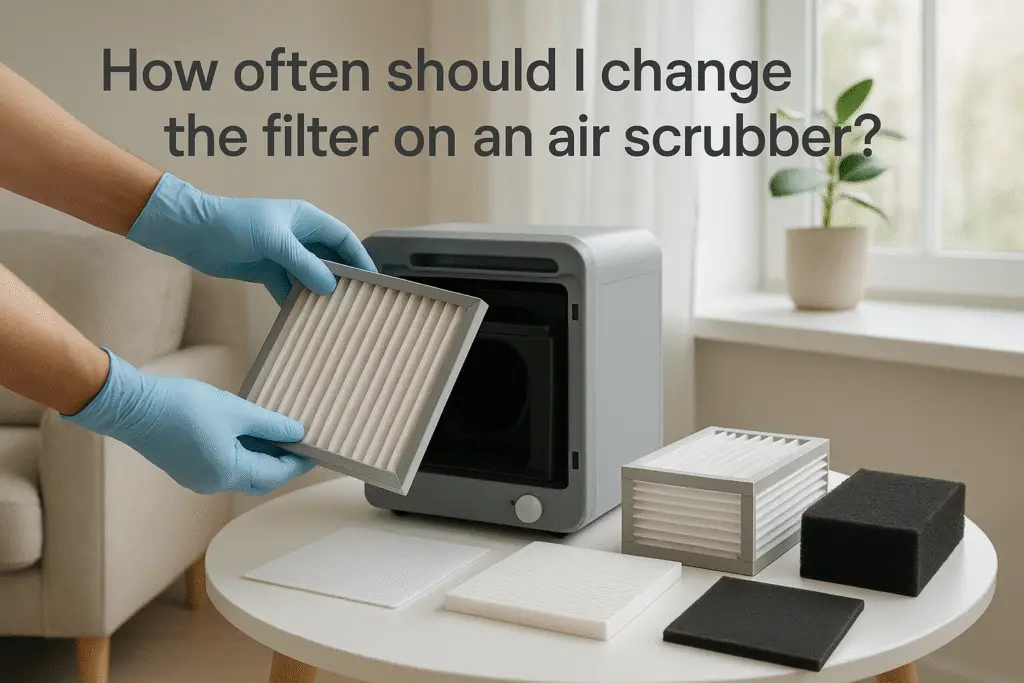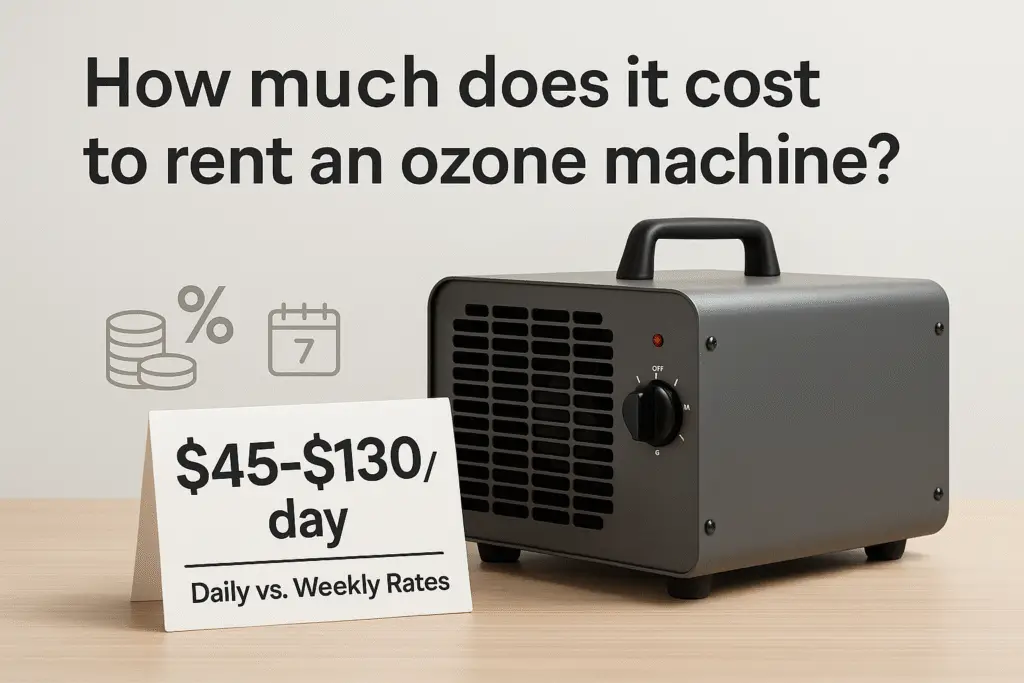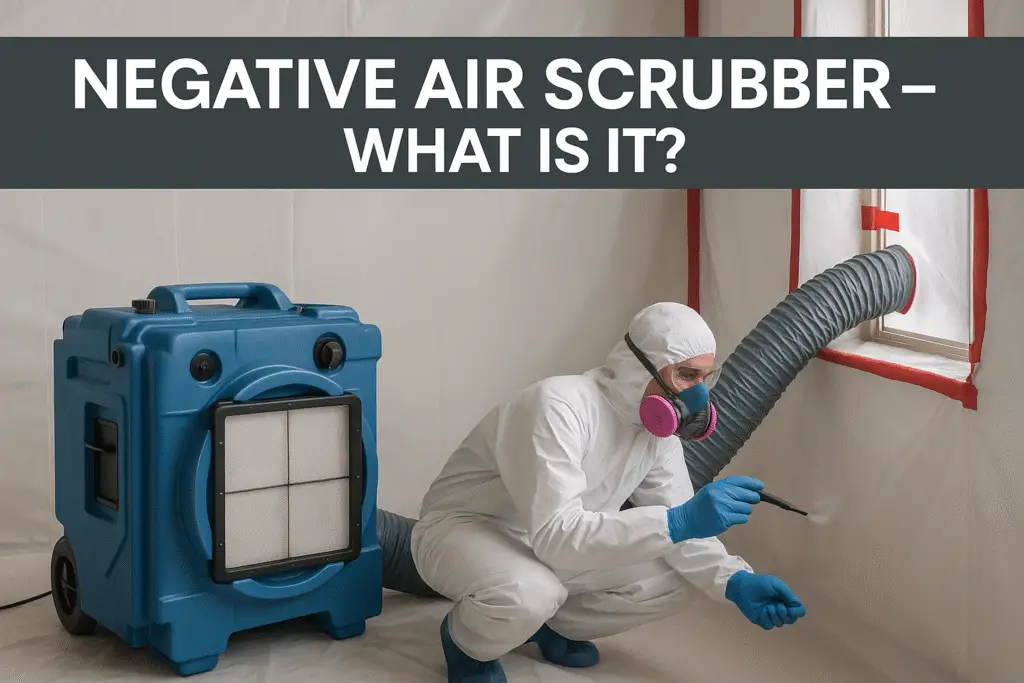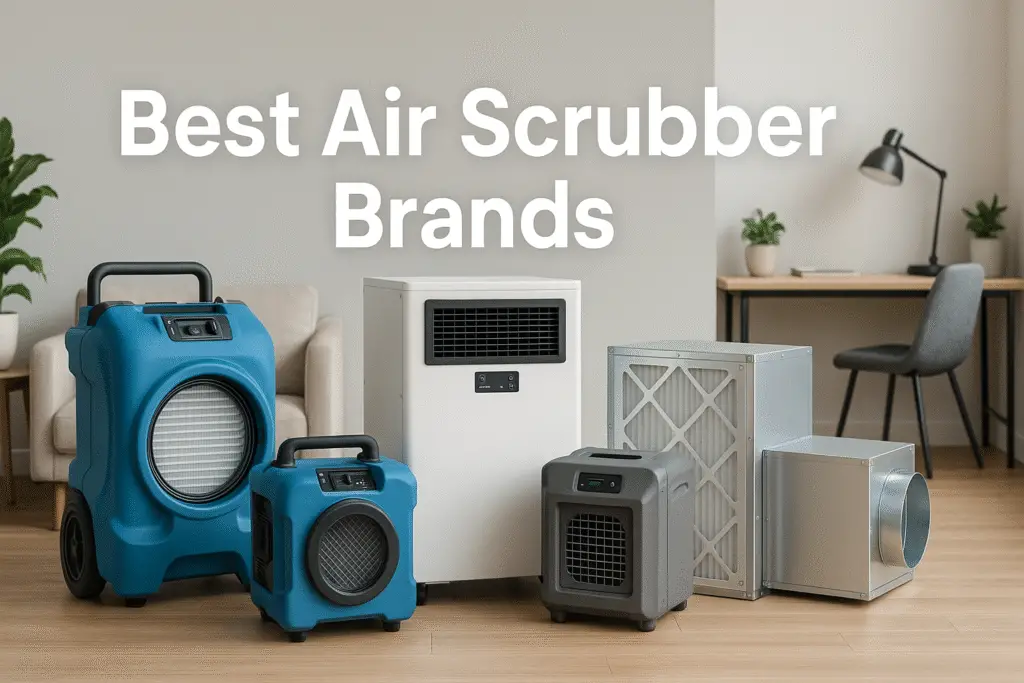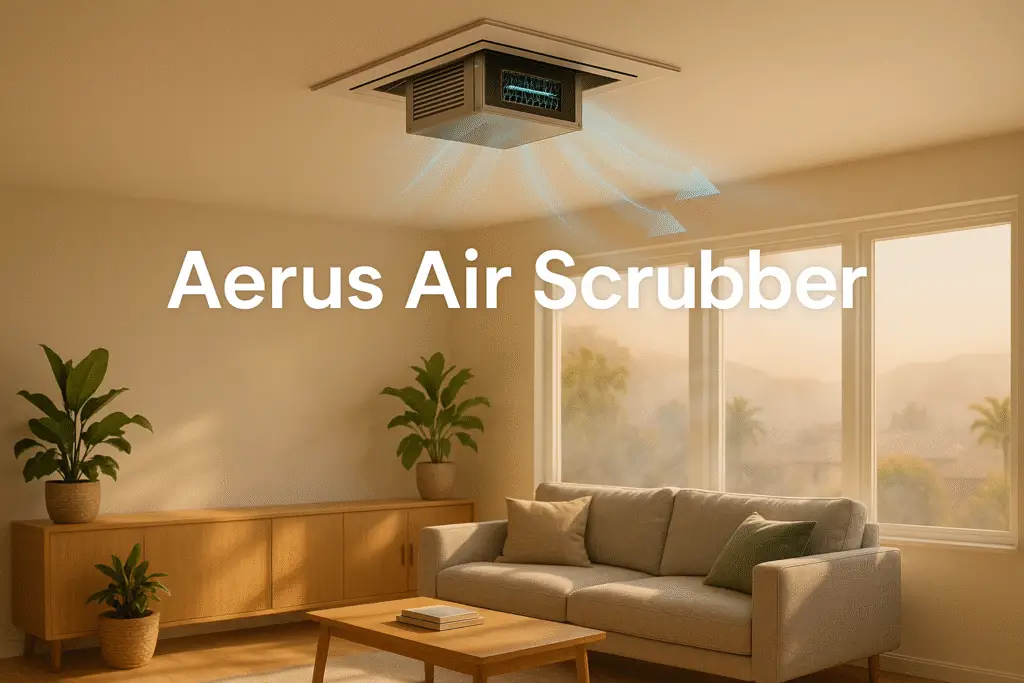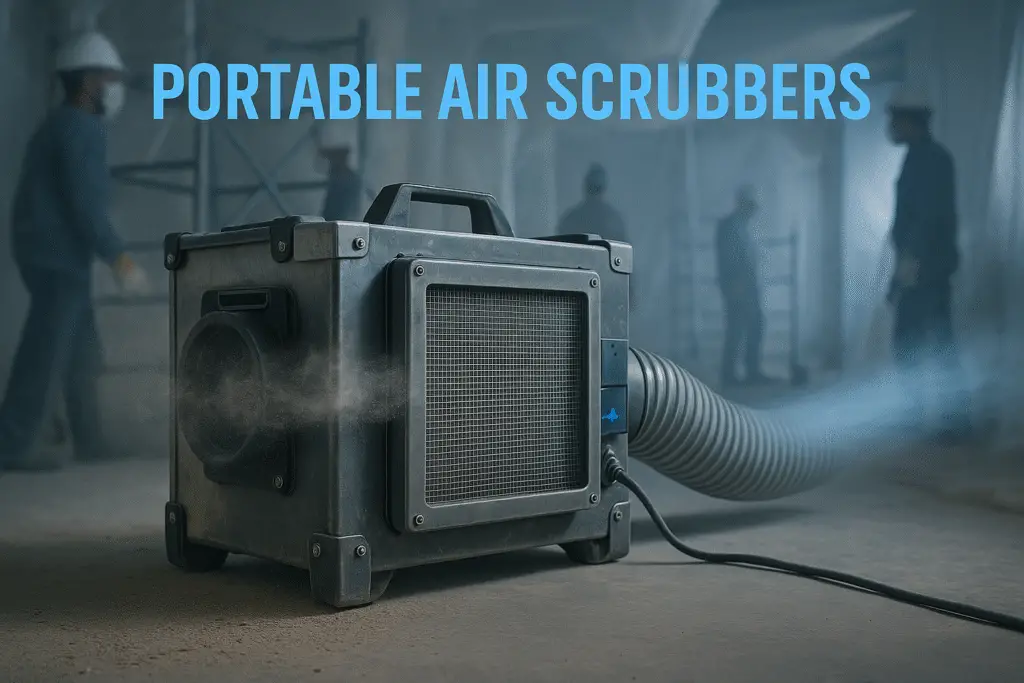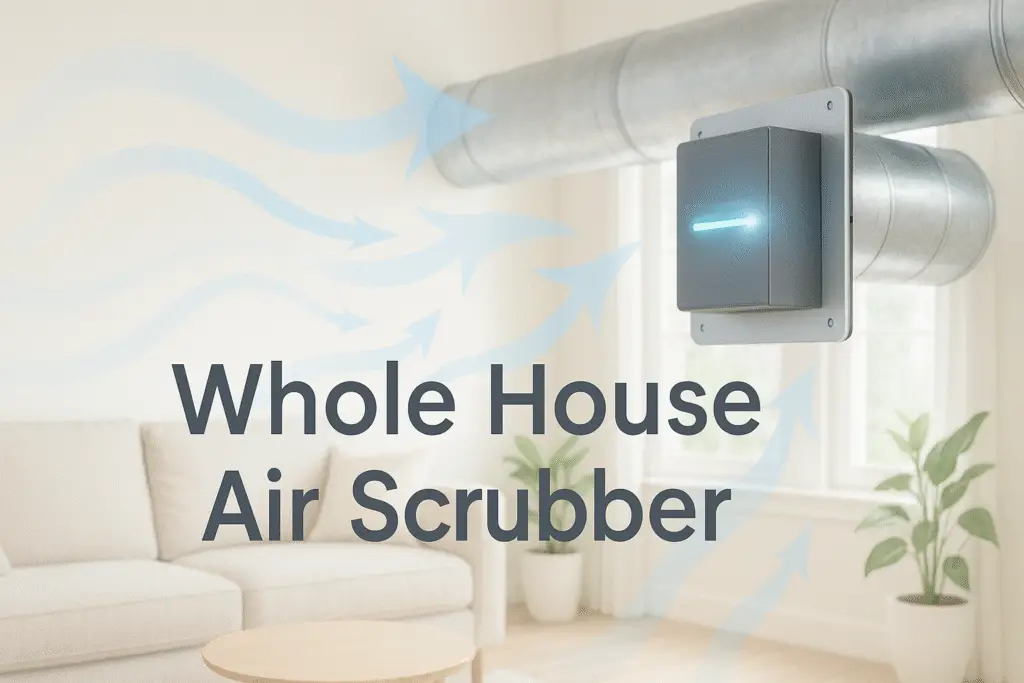Air scrubber filters should be changed every 30-90 days, but this timeline varies significantly based on your specific environment, usage patterns, and filter type. Understanding the proper replacement schedule is crucial for maintaining air quality and equipment efficiency.
Knowing exactly when to replace your air scrubber filter can be challenging. This comprehensive guide will help you identify the optimal replacement timing for your specific situation, recognize warning signs of filter saturation, and implement maintenance strategies that extend filter life while maintaining peak performance.
The Standard Timeline: How Often Air Scrubber Filters Need Changing
Air scrubber filters typically require replacement every 30-90 days according to general industry guidelines. However, this timeframe varies substantially based on filter type, environmental conditions, and usage intensity. According to the American Society of Heating, Refrigerating and Air-Conditioning Engineers (ASHRAE) Standard 62.1, filter maintenance schedules should account for specific operational conditions rather than relying solely on calendar-based intervals.
Dr. Michael Corbett, certified HVAC engineer with 15 years of experience, explains: “The standard 30-90 day replacement guideline serves as a starting point, but your specific environment and system usage patterns ultimately determine the optimal replacement schedule. Facilities with high particulate levels may require monthly replacements, while clean environments might extend to quarterly changes.”
| Photo | Popular Air Purifiers | Price |
|---|---|---|

|
Air Purifiers for Home Large Room up to 1500ft², Tailulu H13 True HEPA Air Purifier for Pets Dust Odor Smoke, Air Purifier for Bedroom with 15dB Quiet Sleep Mode for Bedroom Office Living Room | Check Price On Amazon |
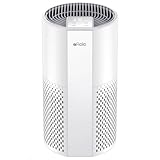
|
Afloia Air Purifier for Home, 4-in-1 Washable Filter for Allergies, Covers Up to 1076 ft², Quiet Operation, Auto Shut-Off & Night Light, Removes Pet Dander, Pollen, Dust, Mold, and Smoke, White,Pluto | Check Price On Amazon |

|
Nuwave OxyPure ZERO Air Purifier with Washable and Reusable Bio Guard Tech Air Filter, Large Room Up to 2002 Ft², Air Quality Monitor, 0.1 Microns, 100% Capture Irritants like Smoke, Dust, Pollen | Check Price On Amazon |

|
Air Purifiers for Home Large Room Up to 1,996 Ft², EOEBOT Air Purifier for Home Pets with Washable Filter, Quiet Sleep Mode, Air Quality Monitor, Air Purifier for Bedroom, Pet Hair, Dust, Smoke, White | Check Price On Amazon |

|
Afloia 2 IN 1 Air Purifier with Humidifier Combo, 3-Stage Filters for Home Allergies Pets Hair Smoker Odors, Evaporative Humidifier, Auto Shut Off, Quiet Air Cleaner with Seven Color Light,White | Check Price On Amazon |
Filter saturation occurs when particulate accumulation reduces airflow and filtration efficiency. Studies show that most filters experience a 5-15% efficiency reduction at the midpoint of their service life and up to 50% reduction when fully saturated. This degradation affects both air quality and system energy consumption.
| Filter Type | Standard Replacement Interval | Influencing Factors |
|---|---|---|
| Pre-filter | 30-60 days | Dust levels, proximity to pollution sources |
| Carbon Filter | 60-90 days | Odor intensity, chemical exposure, humidity |
| HEPA Filter | 6-12 months | Pre-filter maintenance, particulate concentration, airflow volume |
The Environmental Protection Agency (EPA) recommends more frequent filter changes in environments with high pollution levels, during seasons with increased airborne particulates, or in facilities with vulnerable occupants like healthcare settings or spaces with immunocompromised individuals.
General Replacement Guidelines for Different Air Scrubber Filter Types
Different components within multi-stage air scrubbers have distinct lifespans and replacement requirements. Understanding these differences is essential for maintaining optimal system performance.
| Filter Type | Standard Interval | Saturation Signs | Accelerating Factors | MERV Rating |
|---|---|---|---|---|
| Pre-filter | 30-60 days | Visible dust/discoloration, reduced airflow | Construction, pets, high occupancy | 1-4 |
| Medium-Efficiency Filter | 60-90 days | Gray/brown coloration, stiffness | Pollen seasons, nearby traffic | 5-8 |
| Carbon Filter | 60-90 days | Persistent odors, reduced effectiveness | Cooking activities, chemical use | N/A (odor) |
| HEPA Filter | 6-12 months | Significant pressure drop, discoloration | Failed pre-filters, continuous operation | 16-20 |
| ULPA Filter | 12-24 months | Pressure differential exceeding 1″ w.g. | Healthcare/clean room applications | 21+ |
Pre-filters capture larger particles, protecting and extending the life of more expensive HEPA filters. When pre-filters become saturated, the entire filtration cascade is compromised, causing premature loading of downstream components. This interdependence makes regular pre-filter maintenance particularly crucial for system efficiency and cost management.
Manufacturer Recommendations vs. Real-World Requirements
Manufacturer guidelines provide important baseline information but often reflect ideal operating conditions rather than real-world environments. A 2021 study by the Building Science Corporation found that actual filter replacement needs exceeded manufacturer recommendations by 15-40% in high-pollution environments.
For accurate replacement timing, consider these factors when interpreting manufacturer guidelines:
- Manufacturers typically base recommendations on 8-hour daily operation in moderate conditions
- Actual 24/7 operation can reduce filter lifespan by up to 70%
- Published specifications usually reflect laboratory conditions with standardized test dust
- Regional pollutants like wildfire smoke, industrial emissions, or agricultural dust create unique challenges not accounted for in standard guidelines
The International Association of Air Filtration Manufacturers recommends implementing condition-based monitoring rather than relying exclusively on predetermined schedules. This approach involves regular visual inspections and pressure differential measurements to determine actual replacement needs.
The Science Behind Filter Saturation and Efficiency Loss
Filter saturation follows a predictable pattern as particulates accumulate within the filter media. Understanding this process helps identify optimal replacement timing.
According to research by the National Air Filtration Association, filter efficiency follows a paradoxical curve—initially increasing as particles begin to accumulate (creating additional filtration surfaces) before declining as airflow restriction becomes significant. This efficiency peak typically occurs at 30-40% of the filter’s dirt-holding capacity.
The saturation process progresses through these stages:
- Initial operation: Filter media is clean with maximum airflow and baseline efficiency
- Particle loading begins: Efficiency improves slightly as captured particles create additional filtration surfaces
- Mid-life operation: Peak efficiency period with optimal balance between particle capture and airflow
- Progressive restriction: Pressure differential increases, airflow decreases, energy consumption rises
- Critical saturation: Significant airflow restriction occurs with potential for filter bypass and system strain
- Complete saturation: Filter becomes essentially non-functional with severe airflow restriction
Studies from the Department of Energy demonstrate that severely restricted filters can increase energy consumption by 15-30% as systems work harder to maintain airflow. This increased strain can also lead to premature equipment failure and reduced indoor air quality.
7 Critical Signs Your Air Scrubber Filter Needs Immediate Replacement
While calendar-based replacements provide general guidance, recognizing specific indicators of filter saturation allows for condition-based maintenance that optimizes performance and cost. The following seven signs provide reliable criteria for determining when replacement is necessary, regardless of how long the filter has been in service.
Visual Indicators of Filter Degradation (With Example Images)
Visual inspection provides the most accessible method for evaluating filter condition. By examining the filter surface and depth, you can identify key indicators of saturation and performance degradation.
1. Complete surface discoloration
A filter showing uniform gray or brown discoloration across its entire surface indicates significant particulate accumulation. Studies by the Indoor Air Quality Association show that filters with complete surface discoloration typically experience 30-50% reduced efficiency compared to new filters.
What to look for:
- Even, dark coloration across 90-100% of the filter surface
- No visible areas of original filter color
- Gray or brown tint depending on dominant particulate type
2. Visible dust accumulation exceeding 1/8 inch
Substantial dust buildup creating a visible layer on the filter surface indicates advanced saturation. According to ASHRAE research, dust accumulation exceeding 1/8 inch depth correlates with approximately 40% airflow reduction.
What to look for:
- Measurable dust layer on filter surface
- Particulate matter that dislodges when filter is lightly tapped
- Uneven distribution with heavier accumulation on intake side
3. Physical deformation or media collapse
Filter media that shows sagging, collapsing, or separation from the frame indicates structural failure due to excessive particle loading or pressure differential. Testing by filter manufacturers demonstrates that physical deformation typically occurs when filters have exceeded 85-95% of their dirt-holding capacity.
What to look for:
- Visible sagging of filter material between support structures
- Separation between filter media and frame
- Tears or punctures in filter material
Performance Signals That Indicate Filter Saturation
4. Significant airflow reduction (greater than 20%)
Decreased airflow from vents or through the system indicates restricted air passage due to filter saturation. The National Institute for Occupational Safety and Health (NIOSH) identifies a 20% reduction in airflow as the threshold where filter replacement becomes necessary for maintaining adequate ventilation and system efficiency.
How to measure:
- Use an anemometer to measure air velocity at output vents
- Compare readings to baseline measurements taken with a new filter
- Calculate percentage reduction to determine severity
5. Increased system operation time or cycling
When filters become saturated, air handling systems must work harder and longer to maintain desired air quality or temperature conditions. Data from the Department of Energy shows that HVAC systems with restricted filters can experience 10-30% longer runtime periods.
Signs to monitor:
- More frequent system activation
- Extended operation periods
- Difficulty maintaining desired temperature or air quality levels
- Increased energy consumption
6. Persistent odors or reduced odor control
Carbon filters designed for odor removal lose effectiveness as adsorption sites become saturated. According to research published in the Journal of Air & Waste Management Association, carbon filters typically maintain optimal odor removal for 60-90 days under standard conditions before effectiveness declines significantly.
Indicators to notice:
- Persistent odors despite system operation
- Gradual return of odors previously controlled by the system
- Need for higher fan speeds to achieve odor reduction
Using Measurement Tools to Determine Replacement Timing
7. Pressure differential exceeding manufacturer specifications
Measuring the pressure drop across a filter provides the most objective assessment of saturation levels. Most manufacturers specify maximum pressure differential values that indicate when replacement is necessary.
According to the International Society of Automation (ISA), filters should be replaced when pressure drop increases 0.5-1.0 inches water gauge (in.w.g.) above the initial pressure drop of a clean filter. For most residential and light commercial applications, replacement is recommended when pressure differential reaches 0.7-0.9 in.w.g.
Measurement process:
- Install a manometer or magnahelic gauge across the filter
- Record baseline reading with clean filter
- Monitor readings weekly or monthly depending on environment
- Replace filter when reading exceeds manufacturer’s specified maximum
Professional HVAC technician Sarah Martinez notes: “Pressure differential measurement provides the most reliable indicator of filter condition. While visual inspection helps identify obvious saturation, pressure testing quantifies the actual restriction impact on system performance, allowing for optimized replacement timing.”
How Your Environment Drastically Affects Filter Replacement Frequency
Environmental conditions represent the most significant variable influencing filter replacement frequency. A comprehensive analysis of your specific environment allows for accurate prediction of filter lifespan and appropriate maintenance scheduling.
Research published in the Building and Environment journal found that filter replacement needs can vary by up to 400% between different environments, even with identical equipment and filter types. Understanding these environmental factors helps develop customized maintenance schedules that balance performance and cost.
Residential vs. Commercial vs. Industrial Settings
Different facility types present unique filtration challenges due to varying pollutant sources, occupancy patterns, and operational requirements.
| Environment Type | Typical Pollutant Challenges | Replacement Interval Adjustment | Special Considerations |
|---|---|---|---|
| Residential Suburban | Pollen, household dust, pet dander | Standard interval × 1.0 | Seasonal adjustments for pollen seasons |
| Residential Urban | Traffic emissions, fine particulates (PM2.5), soot | Standard interval × 0.7 | Higher concentration of outdoor pollutants |
| Office Environment | Paper dust, printer emissions, bioaerosols | Standard interval × 0.8 | Occupancy-based scheduling, weekend shutdowns |
| Retail Space | High occupancy, outdoor infiltration, door traffic | Standard interval × 0.6 | Entrance filtration systems, high-volume requirements |
| Light Industrial | Process dust, chemical vapors, equipment emissions | Standard interval × 0.5 | Process-specific filtration, localized extraction |
| Heavy Industrial | Metal particulates, combustion byproducts, oils | Standard interval × 0.3 | Multi-stage filtration, specialized media |
| Healthcare | Biological contaminants, pathogens, chemicals | Standard interval × 0.4 | Compliance requirements, infection control |
| Food Processing | Organic particulates, moisture, biological material | Standard interval × 0.4 | Sanitation requirements, moisture resistance |
To assess your specific environment, consider these factors:
- Particulate concentration: The EPA categorizes particulate matter concentration in μg/m³. Environments with PM2.5 levels exceeding 12 μg/m³ typically require 30-50% more frequent filter changes.
- Operating hours: Systems running 24/7 accumulate particulate matter 3 times faster than those operating 8 hours daily.
- Occupancy density: Higher occupancy generates more bioaerosols, skin cells, and activity-related particulates.
- External pollution sources: Proximity to highways, industrial facilities, or construction sites significantly increases particulate load.
Impact of Pets, Cooking, and Household Activities
In residential environments, daily activities substantially impact filter lifespan. Research from the University of Colorado found that common household activities can increase particulate concentrations by 5-10 times baseline levels.
According to Dr. Janice Wilson, indoor air quality specialist: “Many homeowners underestimate how dramatically everyday activities affect their filtration needs. A household with multiple pets and frequent cooking may require monthly filter changes, while a similar home without these factors might maintain acceptable performance with quarterly replacements.”
Activity impact assessment:
| Household Factor | Impact on Filter Lifespan | Adjustment Factor |
|---|---|---|
| Each shedding pet (dog, cat) | Increases particle load by 15-25% | Multiply interval by 0.8 per pet |
| Frequent cooking (daily stovetop use) | Increases particle and grease accumulation by 20-30% | Multiply interval by 0.7 |
| Smoking indoors | Increases particle load by 40-60% | Multiply interval by 0.5 |
| Woodburning fireplace/stove use | Increases particle load by 30-50% during use periods | Multiply interval by 0.6 during heating season |
| Carpeted vs. hard flooring | Carpeting increases airborne dust by 10-15% | Multiply interval by 0.9 for primarily carpeted homes |
| Hobbies (woodworking, crafts) | Increases specific particulates by 20-40% | Multiply interval by 0.7 if regular hobby activities |
The cumulative effect of multiple factors can dramatically reduce filter lifespan. For example, a household with two pets, daily cooking, and carpeted floors might need to replace filters 2-3 times more frequently than the standard recommendation.
Special Considerations for Allergy Sufferers and Sensitive Individuals
Households with allergy sufferers, asthma patients, or immunocompromised individuals require more stringent filtration maintenance. The American Lung Association recommends more frequent filter changes in these environments to maintain optimal air quality.
For sensitive populations, filter replacement should be determined by these additional factors:
- Replace filters at 50-60% of standard intervals to maintain higher average filtration efficiency
- Implement MERV 11-13 filters (minimum) with more frequent replacement rather than higher MERV ratings with extended intervals
- Consider using filter change indicators or schedules based on worst-case conditions rather than average recommendations
- Monitor symptoms as supplementary indicators of filtration effectiveness
Dr. Rebecca Chen, allergist and immunologist, explains: “For patients with respiratory sensitivities, maintaining consistent high-efficiency filtration is more important than maximizing filter lifespan. I recommend replacing filters when they reach approximately 60% of their typical lifespan to maintain optimal air quality.”
Regional and Seasonal Adjustment Factors
Geographic location and seasonal variations significantly impact filtration requirements. Data from the EPA’s Air Quality Index monitoring shows that regional pollutant levels can vary by up to 300% between different locations, while seasonal factors create predictable fluctuation patterns.
Regional adjustment considerations:
- Urban vs. rural environments: Urban areas typically have 30-50% higher particulate concentrations
- Industrial proximity: Areas within 5 miles of industrial zones experience 20-40% higher particulate levels
- Coastal vs. inland locations: Coastal areas often have higher humidity affecting filter performance
- Arid vs. humid climates: Dry climates generate more dust while humid environments promote microbial growth
Seasonal adjustment considerations:
| Season | Typical Challenges | Adjustment Recommendation |
|---|---|---|
| Spring | Pollen, increased outdoor activity | Reduce interval by 20-30% during peak pollen season |
| Summer | Increased system usage, higher humidity | Reduce interval by 10-20% during highest usage months |
| Fall | Leaf debris, mold spores | Reduce interval by 15-25% during leaf season |
| Winter | Closed environments, heating system particulates | Reduce interval by 20-30% in primarily heated months |
| Wildfire Season | Smoke, extreme particulate levels | Reduce interval by 50-70% during active fire periods |
The National Weather Service pollution forecasts and local air quality monitoring can provide data for creating region-specific maintenance schedules. Many areas experience predictable annual patterns that can be incorporated into preventive maintenance planning.
Step-by-Step Process for Proper Air Scrubber Filter Replacement
Proper replacement technique ensures optimal system performance and prevents common problems like air bypass and reduced efficiency. Following this systematic procedure will maximize filtration effectiveness and system longevity.
Safety Precautions and Preparation Steps
Before beginning the filter replacement process, take these essential safety measures:
- Power down the system: Turn off the air scrubber at both the unit switch and circuit breaker to prevent electrical hazards and unexpected operation during maintenance.
- Gather personal protective equipment: At minimum, wear disposable gloves and an N95 respirator mask to prevent exposure to accumulated particulates and potential biological contaminants.
- Prepare disposal materials: Have a plastic bag ready for the used filter to contain particulates and prevent redistribution of captured contaminants.
- Assemble necessary tools: Collect any required tools for access panels (typically screwdrivers or hex keys) and a flashlight for inspection.
- Verify replacement filter specifications: Confirm the new filter matches exact specifications for dimensions, MERV rating, and compatibility with your specific air scrubber model.
Environmental health researcher Dr. Martin Lewis emphasizes: “The filter replacement process creates a temporary opportunity for accumulated contaminants to become airborne. Proper PPE and careful handling techniques are essential, particularly in environments where hazardous materials or pathogens may be present.”
Removal and Installation Best Practices
Follow these steps for optimal filter replacement:
- Access the filter compartment: Remove access panels according to manufacturer instructions, typically using the specified fasteners and technique outlined in your user manual.
- Document the orientation: Before removing the old filter, note the airflow direction indicators and orientation to ensure proper installation of the replacement.
- Remove the old filter carefully: Slowly extract the filter, minimizing agitation that could release captured particulates. For heavily loaded filters, consider spraying lightly with water to reduce particle release.
- Seal in disposal bag: Immediately place the used filter in the prepared disposal bag and seal it securely.
- Inspect the filter chamber: Examine the filter housing for:
- Dust accumulation requiring cleaning
- Signs of moisture or microbial growth
- Damaged gaskets or sealing surfaces
- Proper function of retention mechanisms
- Clean the chamber if necessary: Use a HEPA vacuum or damp cloth to remove any debris from the filter housing, focusing on sealing surfaces.
- Check the replacement filter: Verify the new filter is undamaged, with intact frame and media, and matches the specifications of the original.
- Install with correct orientation: Position the new filter following airflow direction indicators (typically arrows on the filter frame) to ensure proper function.
- Ensure proper seating: Position the filter securely against gaskets or sealing surfaces, eliminating potential air bypass paths.
- Secure retention mechanisms: Engage all clips, brackets, or fasteners designed to hold the filter in position according to manufacturer specifications.
- Replace access panels: Reinstall all access panels, ensuring proper alignment and complete closure.
According to HVAC systems engineer Thomas Rodriguez: “The most common filter installation error is improper sealing, which allows air to bypass the filter entirely. This creates the illusion of extended filter life while actually allowing unfiltered air to circulate through the system and reducing overall air quality.”
Post-Replacement Testing and Verification
After installing the new filter, perform these verification steps:
- Restore power: Return power to the system at both the circuit breaker and unit controls.
- Operational test: Run the system for 15-20 minutes to ensure proper operation.
- Airflow verification: Check airflow at outlets to confirm normal operation.
- Listen for abnormal sounds: Unusual noises may indicate improper filter installation or other issues.
- Pressure differential baseline: If equipped with pressure monitoring, record the initial pressure drop across the new filter as a baseline for future comparison.
- Update maintenance records: Document the filter change date, filter type, and any observations for future reference.
- Schedule next replacement: Based on your environment assessment, set a tentative date for the next inspection or replacement.
For optimal maintenance tracking, consider implementing a simple logging system recording:
- Date of each filter change
- Filter condition at replacement
- Any system performance observations
- Environmental factors during the service period
This documentation helps establish patterns specific to your environment and refine future replacement intervals based on actual conditions rather than general guidelines.
Common Filter Replacement Mistakes and How to Avoid Them
Improper filter maintenance practices can undermine air quality and equipment performance despite regular replacements. Understanding and avoiding these common errors ensures optimal system function and cost-effective maintenance.
Improper Timing: Too Early vs. Too Late Consequences
Finding the optimal replacement timing balance prevents both unnecessary costs and performance degradation.
Replacing too early:
While premature replacement isn’t harmful to the system, it creates unnecessary costs and environmental waste. The American Society of Mechanical Engineers estimates that approximately 30% of all filter replacements occur before necessary, representing significant avoidable expense.
Consequences include:
- Increased annual material costs (15-30% higher than optimal)
- Greater environmental impact from manufacturing and disposal
- Unnecessary maintenance labor and system downtime
- Missed opportunity to reach optimal filtration efficiency (which often peaks at moderate loading)
Replacing too late:
Delayed replacement has more serious consequences for both system performance and air quality. Research from the Building Sciences Corporation shows that severely loaded filters can reduce system efficiency by 15-30% while allowing increased particulate circulation.
Consequences include:
- Reduced air quality as filtration efficiency declines
- Increased energy consumption (5-15% higher with severely restricted filters)
- Potential system damage from strain on motors and components
- Possible filter collapse or bypass allowing unfiltered air circulation
- Accumulation of contaminants in downstream components
To avoid timing errors:
- Implement condition-based assessment rather than strict calendar scheduling
- Use the visual and performance indicators described earlier
- Consider installing differential pressure gauges for objective measurement
- Adjust schedules based on seasonal and activity patterns
Incorrect Filter Selection and Compatibility Issues
Using inappropriate filter types or incompatible replacements creates performance problems and potential system damage. A survey by the National Air Filtration Association found that 23% of air quality problems stemmed from incorrect filter specification.
Common selection errors include:
- Incorrect dimensional specifications: Even small size discrepancies create bypass opportunities where unfiltered air circumvents the filter.
- Improper MERV/efficiency rating: Using filters with higher than designed MERV ratings can restrict airflow beyond system capabilities, while lower ratings reduce filtration effectiveness.
- Wrong filter type for contaminants: Selecting media optimized for particles when gases/odors are the primary concern (or vice versa).
- Ignoring manufacturer specifications: Using aftermarket or generic filters without verifying compatibility with specific equipment requirements.
- Mismatched filter progression: In multi-stage systems, using components that create improper filtration sequencing.
To ensure proper filter selection:
- Always reference the original equipment manufacturer specifications
- Verify exact dimensional measurements including thickness
- Confirm appropriate MERV rating for both the system capabilities and air quality requirements
- Select media appropriate for target contaminants (mechanical filtration for particles, activated carbon for gases/odors)
- Maintain consistent specifications when replacing multiple filter stages
HVAC design engineer Rebecca Johnson explains: “The most common filtration mistake I encounter is using filters with excessive MERV ratings. While the intention to improve air quality is understandable, installing MERV 16 filters in systems designed for MERV 8 creates substantial airflow restriction that reduces overall performance and can damage equipment.”
Handling and Storage Errors That Reduce Filter Effectiveness
Improper handling and storage can compromise filter performance even before installation. Laboratory testing by filter manufacturers demonstrates that mishandled filters can experience up to 20% efficiency reduction.
Common handling mistakes include:
- Compression damage: Stacking heavy items on filters or forcing them into tight spaces crushes filter media and creates channels for bypass.
- Contamination before use: Storing filters in dusty areas or without protective wrapping leads to premature loading.
- Moisture exposure: Storing filters in humid environments or areas with water exposure promotes microbial growth and media degradation.
- Frame damage: Rough handling that bends frames or corners prevents proper sealing when installed.
- Touching filter media: Direct contact with filter material can damage fine fibers and create inconsistent density.
Proper handling and storage practices:
- Store filters in their original packaging until installation
- Maintain storage in clean, dry environments away from direct sunlight
- Position filters vertically rather than stacked when possible
- Handle filters by the frame only, avoiding contact with filter media
- Inspect for damage immediately before installation
- Maintain inventory rotation using first-in, first-out principles
The National Air Filtration Association recommends storing replacement filters in conditions similar to their intended operating environment and implementing quality control inspections before installation to identify any shipping or storage damage.
Cost Optimization Strategies for Air Scrubber Filter Maintenance
Strategic maintenance planning balances immediate costs with long-term performance and equipment longevity. Implementing optimization strategies can reduce overall filtration expenses while maintaining or improving air quality.
Long-Term Cost Analysis of Different Replacement Schedules
Different replacement approaches create distinct cost structures and performance outcomes. Understanding these differences allows for informed maintenance decisions based on specific priorities and constraints.
Cost comparison of common replacement strategies:
| Replacement Strategy | Initial Costs | Operational Costs | System Impact | Air Quality Impact |
|---|---|---|---|---|
| Fixed Calendar Schedule | Medium (predictable) | Medium (some waste) | Neutral to Positive | Good (consistent) |
| Run-to-Failure | Lowest (extended intervals) | Highest (energy penalty, repair risk) | Negative (increased wear) | Poor (declining quality) |
| Condition-Based | Medium-High (monitoring equipment) | Lowest (optimized timing) | Positive (optimized operation) | Excellent (maintained standards) |
| Conservative/Early | Highest (frequent replacement) | Medium-High (material waste) | Positive (minimal restriction) | Excellent (consistent high quality) |
Cost calculation example for a typical commercial air scrubber:
- Annual filter costs: Filter price × replacement frequency
- Energy consumption impact: Approximately 5% increase for each 0.1 in.w.g. pressure increase
- Labor costs: Maintenance hours × hourly rate × replacement frequency
- System longevity impact: Equipment life reduction from inappropriate maintenance
According to facility management data compiled by the International Facility Management Association, condition-based replacement typically reduces total filtration costs by 15-25% compared to fixed schedules while maintaining equal or better air quality.
Factors affecting optimal replacement strategy:
- Critical nature of air quality requirements
- Sensitivity of occupants or processes
- Energy cost significance in operational budget
- Availability of maintenance personnel
- Regulatory or certification requirements
Pre-Filter Maintenance to Extend Main Filter Life
Strategic pre-filtration significantly extends the life of more expensive primary filters. Studies by the National Air Filtration Association demonstrate that properly maintained pre-filters can extend HEPA filter life by 30-50%.
Effective pre-filter strategies:
- Implement multi-stage filtration: Use progressively higher efficiency filters in series (MERV 7-8 → MERV 11-13 → HEPA) to extend final stage life.
- Replace pre-filters more frequently: Establish accelerated replacement schedules for lower-cost preliminary stages.
- Consider washable pre-filters: In appropriate applications, cleanable pre-filters reduce replacement costs while maintaining protection.
- Install extended surface pre-filters: Pleated or extended media pre-filters offer greater capacity than flat panel alternatives.
- Address specific contaminants: Use specialized pre-filters targeting predominant pollutants in your environment.
Cost impact example:
A hospital air handling system using $50 pre-filters replaced monthly ($600/year) to protect $500 HEPA filters can extend HEPA replacement from annually to every 18-24 months, saving approximately $250-500 annually per filter assembly while maintaining air quality standards.
Environmental engineer Dr. James Peterson notes: “The most cost-effective filtration strategy typically involves more frequent replacement of inexpensive pre-filters to protect higher-cost final filters. This approach not only reduces material costs but also minimizes system pressure drop, generating energy savings throughout the filtration cycle.”
Comparing Budget vs. Premium Filter Options
Filter quality and cost vary significantly across manufacturers and specifications. Understanding the true cost-benefit relationship helps optimize selection for specific applications.
Performance comparison factors:
| Filter Attribute | Budget Filters | Mid-Range Filters | Premium Filters |
|---|---|---|---|
| Initial Cost | Lowest ($) | Moderate ($$) | Highest ($$$) |
| Dirt-Holding Capacity | 30-50% of premium | 60-80% of premium | Maximum capacity |
| Media Consistency | Variable, potential gaps | Good uniformity | Excellent uniformity |
| Frame Integrity | Basic, potential leakage | Good sealing | Superior sealing, reinforced |
| Initial Pressure Drop | Often higher | Moderate | Optimized (lowest) |
| Service Life | Shortest | Average | Extended |
| True Annual Cost | Often highest | Moderate | Often lowest |
Research by the National Air Filtration Association demonstrates that premium filters typically offer 2-3 times the service life of budget alternatives while maintaining lower pressure drop throughout their lifespan. This extended service life combined with energy efficiency often results in lower total cost despite higher initial purchase price.
Selection guidelines by application:
- Critical environments (healthcare, clean rooms, sensitive manufacturing): Premium filters provide consistent performance and reliability
- Standard commercial applications (offices, retail): Mid-range filters typically offer optimal cost-benefit balance
- Temporary or short-term needs: Budget filters may provide adequate performance for limited duration applications
To calculate true filter cost:
True Annual Cost = (Filter Price × Annual Replacements) + Energy Cost Impact + Labor Cost
Where Energy Cost Impact = System kW × Hours Operation × Energy Rate × Pressure Drop Factor
Advanced Technologies for Monitoring Filter Condition
Modern monitoring technologies enable transition from schedule-based to condition-based maintenance, optimizing replacement timing and reducing costs while maintaining air quality standards.
Smart Air Scrubbers with Automatic Replacement Indicators
Next-generation air purification systems incorporate integrated monitoring capabilities that provide objective data on filter condition and replacement timing. According to market research by the Building Services Research and Information Association, smart filtration monitoring can reduce maintenance costs by 20-30% while improving air quality consistency.
Common smart monitoring technologies include:
- Differential pressure sensors: Continuously measure resistance across filters, providing precise loading status
- Optical particle sensors: Monitor downstream air quality to detect filtration efficiency changes
- Airflow measurement: Track system airflow to identify restriction from filter loading
- Runtime calculators: Estimate filter condition based on operational hours and environmental factors
- IoT connectivity: Transmit filter status to building management systems or maintenance personnel
Leading manufacturers now offer systems with:
- Mobile applications displaying real-time filter status
- Predictive algorithms estimating remaining filter life
- Automatic maintenance notifications when thresholds are reached
- Performance history logging for optimization analysis
- Remote monitoring capabilities for facility management
HVAC systems specialist Michael Chen explains: “Smart monitoring represents the future of filtration maintenance. By replacing arbitrary schedules with data-driven decisions, these systems eliminate both premature replacements and performance degradation while reducing the administrative burden of maintenance tracking.”
DIY Monitoring Methods and Tools
For systems without integrated monitoring, several affordable approaches allow implementation of condition-based maintenance.
Effective DIY monitoring solutions:
- Retrofittable pressure gauges: Magnahelic or digital differential pressure gauges ($50-150) can be installed across filter banks to provide objective loading measurement.
- Install pressure taps before and after filters
- Record baseline reading with new filters
- Establish replacement threshold based on manufacturer specifications
- Monitor readings at regular intervals
- Airflow measurement tools: Handheld anemometers ($30-100) can track changes in system output.
- Measure airflow at consistent locations
- Document baseline readings with new filters
- Replace when airflow decreases by 20-25%
- Visual inspection cards: Standardized comparison guides help assess filter condition consistently.
- Create or purchase color reference cards
- Compare filter appearance to standardized images
- Document progressive changes
- Calendar monitoring with environmental adjustments: Enhanced scheduling systems accounting for variable conditions.
- Begin with manufacturer’s recommended interval
- Adjust based on environmental factors discussed previously
- Document actual condition at each change
- Refine future schedules based on observations
Cost-benefit analysis shows that even basic monitoring tools typically pay for themselves within 3-6 months through optimized replacement timing, according to research published in ASHRAE Journal.
Professional Assessment Techniques for Complex Systems
For critical applications or complex systems, professional assessment provides comprehensive evaluation of filtration performance and optimal maintenance scheduling.
Professional assessment typically includes:
- Comprehensive system evaluation: Analysis of the entire air handling system including:
- Airflow measurement at multiple points
- Static pressure mapping throughout system
- Leakage identification
- Component condition assessment
- Particle counting analysis: Measurement of particulate concentrations before and after filtration to determine actual efficiency.
- Quantifies filtration effectiveness by particle size
- Identifies filtration gaps or bypass issues
- Provides objective performance measurement
- Computerized maintenance management: Implementation of data-driven maintenance scheduling.
- Documents system-specific performance patterns
- Generates optimized replacement schedules
- Tracks maintenance history and performance trends
- Thermal imaging assessment: Identifies airflow patterns and potential bypass issues.
- Visualizes air distribution patterns
- Locates leakage or bypass points
- Confirms proper installation and sealing
The International Society for Automation recommends professional assessment annually for critical systems and when implementing new filtration strategies or equipment changes.
Building performance engineer Dr. Sarah Williams notes: “Professional assessment is particularly valuable for complex or mission-critical applications like healthcare facilities, clean manufacturing, and data centers. The cost of assessment is typically offset many times over through optimization of both replacement schedules and system performance.”
Environmental Considerations for Air Scrubber Filter Disposal
Proper disposal of used filters completes the maintenance cycle while ensuring environmental responsibility and regulatory compliance. Different filter types and contaminant loads require specific handling and disposal approaches.
Proper Disposal Methods for Different Filter Types
Filter disposal requirements vary based on construction materials and captured contaminants. The EPA provides guidelines for different filter classifications, with additional requirements from state and local authorities.
Standard disposal guidelines by filter type:
| Filter Type | Material Composition | Standard Disposal Method | Special Considerations |
|---|---|---|---|
| Fiberglass Panel Filters | Fiberglass, cardboard frame | General waste (landfill) | Typically non-recyclable due to mixed materials |
| Synthetic Media Filters | Polyester/polymer media, plastic/metal frame | General waste (landfill) | May be recyclable if disassembled by specialized facilities |
| Activated Carbon Filters | Carbon granules, polymer substrate | General waste (landfill) | Potential for specialized recycling of carbon content |
| HEPA Filters | Fiberglass/synthetic microfibers | General waste with proper containment | Double-bagging recommended to contain fine particles |
| Metal Mesh Filters | Aluminum, stainless steel | Metal recycling (if cleaned) | Most recyclable filter type if properly cleaned |
Modified disposal requirements for contaminated filters:
- Biological contaminants (healthcare, laboratories): May require biohazard disposal procedures
- Heavy metals or toxic materials (industrial applications): May require hazardous waste handling
- Radioactive particles (specialized applications): Require certified radioactive waste protocols
- Chemical contaminants (manufacturing, processing): May require special handling based on captured chemicals
Environmental compliance specialist Jennifer Martinez advises: “The default assumption that all used filters can go in general waste is often incorrect. Facilities should evaluate their specific contaminant profile and consult local regulations to determine appropriate disposal methods, particularly for specialized applications or environments with hazardous materials.”
Recycling Options and Sustainability Practices
While many filters end up in landfills, emerging recycling technologies and practices are creating more sustainable alternatives. The Air-Conditioning, Heating, and Refrigeration Institute reports that filter recycling programs can divert 60-80% of filter materials from landfills in participating facilities.
Current recycling opportunities include:
- Frame separation programs: Some manufacturers and third-party recyclers accept filters for disassembly and material separation.
- Metal frames are recycled as scrap metal
- Some plastic frames can be reprocessed
- Filter media typically still requires disposal
- Washable/reusable filter options: For appropriate applications, selecting cleanable filters significantly reduces waste.
- Metal mesh filters can be cleaned and reused for years
- Some electrostatic filters are designed for washing and reuse
- Generally limited to pre-filter applications
- Specialized carbon recycling: Several companies now offer regeneration services for activated carbon filters.
- Thermal processing removes captured contaminants
- Regenerated carbon can be reused in new filters
- Primarily available for commercial/industrial quantities
- Manufacturer take-back programs: Some premium filter manufacturers offer return programs for proper recycling/disposal.
- May provide shipping containers for used filters
- Often include tracking for environmental reporting
- Typically available for commercial/institutional customers
Sustainability best practices:
- Select filters with separable components when possible
- Consider lifecycle environmental impact in filter selection
- Implement optimized replacement schedules to reduce material consumption
- Explore manufacturer programs for recycling or proper disposal
- Document waste diversion for environmental reporting
Reducing Environmental Impact Through Optimal Replacement Timing
Proper maintenance scheduling itself represents an environmental strategy by balancing resource consumption with system efficiency. Research by the Department of Energy demonstrates that optimized filter maintenance reduces both material waste and energy consumption.
Environmental impact factors of filter replacement timing:
- Premature replacement: Increases material consumption and manufacturing energy
- Delayed replacement: Increases operating energy and potential system damage
- Optimal replacement: Minimizes combined impact of materials and energy
Comprehensive environmental analysis by Carnegie Mellon University researchers found that the optimal environmental replacement point typically occurs when filters reach 60-70% of their maximum loading capacity, balancing material consumption with energy efficiency.
Strategies for environmental optimization:
- Implement condition-based monitoring to replace filters at optimal points
- Select high-capacity filters with extended service life for reduced material consumption
- Maintain multi-stage filtration to optimize lifespan of all components
- Document and analyze actual replacement conditions to refine timing
- Consider total environmental impact (materials + energy) in maintenance planning
Environmental engineer Dr. Rebecca Nelson explains: “The most sustainable approach to filter maintenance isn’t simply extending replacement intervals as long as possible. Instead, it’s finding the sweet spot where the combined environmental impacts of manufacturing, operation, and disposal are minimized through data-driven maintenance decisions.”
Conclusion: Creating Your Customized Filter Replacement Strategy
Determining the optimal filter replacement schedule for your air scrubber requires balancing manufacturer guidelines with your specific environmental conditions, usage patterns, and performance requirements. By implementing the following approach, you can develop a maintenance strategy that optimizes air quality, system performance, and operational costs:
- Establish your baseline: Begin with manufacturer recommendations and standard intervals for your filter types.
- Assess your environment: Evaluate particulate levels, pollutant sources, occupancy patterns, and seasonal factors.
- Implement monitoring: Select appropriate condition-based assessment tools ranging from visual inspection to pressure differential measurement.
- Document performance: Record actual filter conditions at replacement to refine future timing.
- Optimize multi-stage systems: Develop coordinated replacement schedules for different filter stages.
- Consider total costs: Balance material costs with energy consumption and system performance.
- Address disposal properly: Ensure appropriate handling and disposal/recycling based on filter type and contaminants.
By moving beyond simple calendar-based replacement to condition-based maintenance informed by your specific circumstances, you can achieve optimal performance, cost efficiency, and environmental responsibility in your air scrubber filter maintenance program.
Remember that filter replacement is not merely a maintenance task but an essential component of indoor air quality management, system efficiency, and equipment longevity. The time and attention invested in optimizing this process yields significant returns in both performance and cost savings.
